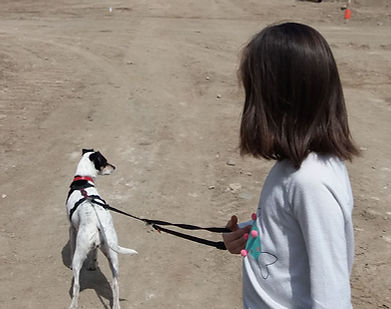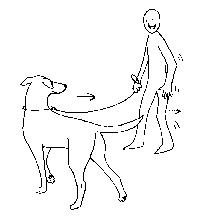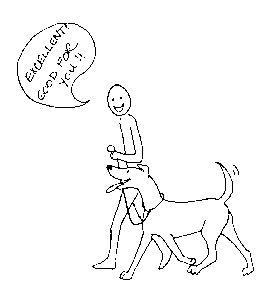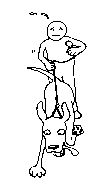
Making tails wag since 1996!
3400 N. Monroe St. - Spokane, WA
Questions? EMAIL!
It's not just your dog! It takes two to pull.
Dogs do not pull if there is no one dangling at the end of the leash!
Both you and your dog need to break old habits.
"A Leash is to the Dog-Human connection like a seat-belt is to the car-driver connection. Both are safety devices and often mandated by law. Just as we never use a seat-belt to drive our car, we should not use a leash to “drive” our dogs. A leash allows us a safe and effective connection to our dogs in case of surprises, emergencies, or situations where attention is hard to get or keep." ....
Your dog pulls because someone, somewhere
at some time, took a step when he put tension on the leash.
He pulls - because it works!
Does Your Dog Pull On Leash?


photo courtesy of Laura Felgenhauer
He continues to pull because it continues to be a rewarding experience. He pulls, and he gets to the car. He pulls and he gets to greet that other dog in class. He pulls and the neighbor lady across the street tells him how lovely he is, even though he is now not JUST pulling but is also climbing up the front of her with his muddy dog paws, to which she replies, "it's ok, I don't mind!"
WHAT DOES A SLACK LEASH LOOK LIKE?


A slack leash hangs like the letter "J" - down from your hand and up to where the snap meets the collar. The snap hangs toward the floor when the leash is slack, not up toward your hand.

Tight leash - resistance.

Loose leash - cooperation.
Don't give your dog anything to lean against.
The more tension you apply, the more he shifts his weight to compensate. Keep the leash slack!
Lead with the food, pat your leg, make happy noises, encourage and cheer - don't pull.

This is what loose leash walking looks like! There's a "smile" in the leash.
What gets rewarded, gets repeated.
Here is the elusive answer to the ever present question of HOW DO I TEACH MY DOG NOT TO PULL?? (Shhhhh - it's a secret!)
Don't walk forward if there is tension on the leash.
When the dog is about to apply ANY tension to the leash at all ....

Immediately stop.
Be a tree.


When the dog turns to see what happened to you, praise for his attention ....

and encourage the dog back into heel position next to you - if necessary, take a few steps backward.
As long as the dog is in the magic spot next to your leg, continue praising, give food rewards, make it the best possible place in the world to be. If he loses concentration and is about to put any tension on the leash at all, stop and repeat the above sequence.

Sounds way too simple doesn't it?
Simply STOP every single time you note that the dog is *about to* put the slightest tension on the leash and the pulling will go away. (Yeah, right.) No, honest - It really, really works! The truth is, that if you tire your dog out first with a good game of fetch and then take him for a walk in a quiet non-distracting place every day this week with only ONE goal: to walk without tension and you absolutely refuse to take a single forward step when you feel tension on the leash, he will discover that pulling is "broken" and that the tension is a cue to slacken the lead. You will see the lightbulb go on when he realizes this. If you are consistent and don't give up, he will learn it. He will have good days and bad, but if you are diligent he will figure it out.
Hi,
I just wanted to drop you guys a line thanking you for some great advice I found in your behavior FAQ. I adopted a two-year-old, 100 pound American Akita recently. He was exceptionally well behaved except when I took him out to walk. He would pull on the leash with all his strength pretty much the whole time we were outside. We had one of those retractible leashes and he actually pulled so hard he broke the winding mechanism inside and pulled the nylon ribbon out of the casing. It was annoying for me trying to hold on to him and probably unpleasant for him since he would practically choke himself on the collar trying to lunge forward (to look at him without seeing the leash, head downand legs straining, you would think someone had hooked the poor guy up to a plough and was trying to get him to till a field).
I looked around on google and found your behavior FAQ. Starting on Sunday (April 1), I implemented the method you suggest on all of his walks --rewarding him when he stays close to me and freezing when he puts any tension on the leash. The first few days were frustrating, but after that,the change was remarkable. By Wednesday evening, slack on the leash was the norm, though i still had to correct him a few times. On the two walks we took today (saturday the 7th), there has been slack on the leash the whole time. Our walks have become a lot more pleasant -- hes like a whole different dog when I take him out now. Thanks a lot for the information.
- Jason
The other problem is that YOU want to get where you are going as much as your dog does.
Responding you your dog's pull has been rewarding to you, too. You are probably thinking right this instant: "How will I ever get to the car, the park, the house, by standing still for heaven's sake?"


First we must break YOUR habit!
It is as much an ingrained habit to you as it is your dog. He cues you to take that step by putting tension on the leash and you dutifully obey. He has trained you to respond and you are fluent in the art of following his lead. You do it without thinking. He pulls without thinking.
Be consistent.
Don't have a great training session and have super results and then mess it up and undo all the hard work you've done by allowing your dog to drag you to the car when you are late to class. You must never move forward when the leash is tight. Put all your supplies in the car first so you aren't juggling your purse, your training supplies and can concentrate on your dog. Do one step sit, one step sit, one step sit all the way to the car if necessary, but DO NOT allow your dog to drag you where he wants to go.
LET GO OF THAT LEASH - it will keep you from pulling!
Noooo that doesn't mean turn your dog loose to run in traffic, TIE THE LEASH SECURELY TO YOUR WAIST OR STRONG BELT or better yet, use a hands-free waist leash. This will keep you from pulling. The only thing in your hand is your food reward or a favorite toy hidden in your pocket. These items will be delivered when the dog makes the right choice. If you "feel" your dog decide not to pull, PRAISE AND REWARD lavishly !!! Reward any lessening of the tension by proceeding forward. Deliver the reward at the seam of your pantleg as you step in next to your dog to reinforce that magic position.
BACK AND TO THE RIGHT.
What if you stop and he just keeps pulling? Stop for a couple of seconds and wait, if your dog continues to strain like a maniac, turn and walk away from your dog (imagine you are facing 12 on the clock, you are going to turn and head for 4 o'clock.) The diagonal direction will set him off balance and he will turn toward you, as he catches up, PRAISE and deliver a treat in heel position - next to the seam of your pantleg. (This assumes that the dog is walking on your left side. If he is on your right, you will turn and head for 8 o'clock.) Then continue on your way.
Lovely handling. Using a hand target, she guides her dog to follow her while keeping the leash slack. It's very hard for your dog to move passed another puppy. Remember to praise and reward whenever your dog chooses YOU over a distraction!
See also:
Leashes - The Good, The Bad, The Ugly ... - by Lisa Edwards, CPDT, CDBC
This handout may be reprinted in its entirety for distribution free of charge and with full credit given:
© CAROL A. BYRNES "DIAMONDS IN THE RUFF" Training for Dogs & Their People -
ditr_training @ hotmail.com - http://www.diamondsintheruff.com